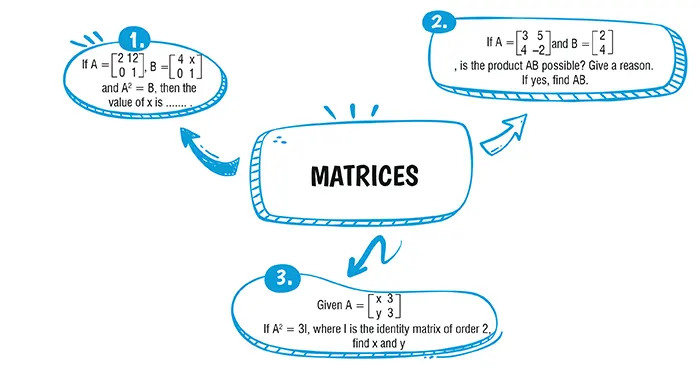Table of Contents

Ans. (c) 36
Explanation:
Let,
A^2 = B \\
⇒ A, A,= B \\
⇒ \begin{bmatrix} 2 & 12 \\ 0 & 1 \end{bmatrix}\begin{bmatrix} 2 & 12 \\ 0 & 1 \end{bmatrix}
=\begin{bmatrix} 4 & x \\ 0 & 1 \end{bmatrix}\\
⇒ \begin{bmatrix} 4 & 36 \\ 0 & 1 \end{bmatrix}
= \begin{bmatrix} 4 & x \\ 0 & 1 \end{bmatrix} \\
⇒ x = 36
Ans. (a)
Explanation:
we have,
AB = \begin{bmatrix} 2 & -1 \\ 2 & 0 \end{bmatrix}\begin{bmatrix} 1 & 0 \\ 0 & 0 \end{bmatrix}\\
=\begin{bmatrix} 2 & -2 \\ 2 & 0 \end{bmatrix}
\begin{bmatrix} 2 & -2 \\ 2 & 0 \end{bmatrix} + \begin{bmatrix} -3 & 2 \\ 4 & 0 \end{bmatrix} \\
∴ AB + C = \begin{bmatrix} -1 & 0 \\ 6 & 0 \end{bmatrix}
Explanation:
A \begin{bmatrix} 3 & 5 \\ 4 & -2 \end{bmatrix}_{2×2} and B = \begin{bmatrix} 2 \\ 4 \end{bmatrix}_{2×1} \\
The product AB is possible as the number of columns in A is equal to the number of rows in B.
\text{Now} \space AB = \begin{bmatrix} 3 & 5 \\ 4 & -2\end{bmatrix}\begin{bmatrix} 2\\ 4\end{bmatrix} = \begin{bmatrix} 3×2+5×4\\ 4 × 2 + (-2) × 4\end{bmatrix}
= \begin{bmatrix} 26 \\ 0\end{bmatrix}
Explanation:
Also A^2= 3I \\
\Rightarrow \begin{bmatrix} x & 3 \\ y & 3 \end{bmatrix}\begin{bmatrix} x & 3 \\ y & 3 \end{bmatrix} = 3 \begin{bmatrix} 1 & 0 \\ 0 & 1 \end{bmatrix} \\
\Rightarrow \begin{bmatrix} x^2+3y & 3x+9 \\ xy+3y & 3y+9 \end{bmatrix} = \begin{bmatrix} 3 & 0 \\ 0 & 3 \end{bmatrix} \\
\text{Comparing both sides,} \\
\text{we get,} \\
3x + 9 = 0 \\
⇒ x = -\frac{9}{3} \\
= -3 \space and \space 3y + 9 = 3 \\
⟹ 3y = 3 – 9 = – 6 \\
⟹ y=-\frac{6}{3}=-2 \\
∴ x=−3 and y=−2
Explanation:
LET A= \begin{bmatrix} 2 & 1 \\ 0 & -2\end{bmatrix}, B= \begin{bmatrix} 4 & 1 \\ -3 & -2\end{bmatrix} and C= \begin{bmatrix} -3 & 2 \\ -1 & 4\end{bmatrix} \\
A^2 = \begin{bmatrix} 2 & 1 \\ 0 & -2\end{bmatrix}\begin{bmatrix} 2 & 1 \\ 0 & -2\end{bmatrix} = \begin{bmatrix} 4+0 & 2-2 \\ 0 & 0+4\end{bmatrix} = \begin{bmatrix} 4 & 0 \\ 0 & 4\end{bmatrix} \\
5B= \begin{bmatrix} 20 & 5 \\ -15 & -10\end{bmatrix} \\
AC = \begin{bmatrix} 2 & 1 \\ 0 & -2\end{bmatrix}\begin{bmatrix} -3 & 2 \\ -1 & 4\end{bmatrix}
=\begin{bmatrix} -6-1 & 4+4 \\ 0+2 & 0-8\end{bmatrix} = \begin{bmatrix} -7 & 8 \\ 2 & -8\end{bmatrix} \\
∴ A^2+ AC – 5B \\
=\begin{bmatrix} 4 & 0 \\ 0 & 4 \end{bmatrix} + \begin{bmatrix} -7 & 8 \\ 2 & -8 \end{bmatrix} - \begin{bmatrix} 20 & -5 \\ 2 & -8 \end{bmatrix} \\
= \begin{bmatrix} 4-7-20 & 0+8-5 \\ 0+2+15 & 4-8+10 \end{bmatrix}
= \begin{bmatrix} -23 & 3 \\ 17 & 6 \end{bmatrix}
Download Mind Map of this chapter
Download NowWant to Practice Mock Tests of this chapter
Practice NowDownload Important Questions of this chapter
Download Now| Chapter No. | Chapter Name |
|---|---|
| Chapter 1 | Goods and Service Tax (GST) |
| Chapter 2 | Banking |
| Chapter 3 | Shares and Dividends |
| Chapter 4 | Linear inequations |
| Chapter 5 | Quadratic Equations in one variable |
| Chapter 6 | Ratio and proportion |
| Chapter 7 | Factorization |
| Chapter 8 | Matrices |
| Chapter 9 | Arithmetic Progression |
| Chapter 10 | Geometric Progression |
| Chapter 11 | Coordinate Geometry |
| Chapter 12 | Reflection |
| Chapter 13 | Similarity |
| Chapter 14 | Loci |
| Chapter 15 | Circles |
| Chapter 16 | Constructions |
| Chapter 17 | Mensuration |
| Chapter 18 | Trigonometry |
| Chapter 19 | Statistics |
| Chapter 20 | Probability |
| Chapter Wise Important Questions for ICSE Board Class 10 Mathematics |
|---|
| Goods and Service Tax (GST) |
| Banking |
| Shares and Dividends |
| Linear inequations |
| Quadratic Equations in one variable |
| Ratio and proportion |
| Factorization |
| Matrices |
| Arithmetic Progression |
| Geometric Progression |
| Coordinate Geometry |
| Reflection |
| Similarity |
| Loci |
| Circles |
| Constructions |
| Mensuration |
| Trigonometry |
| Statistics |
| Probability |
CBSE Important Questions Class 10
ICSE Important Questions Class 10
CBSE Important Questions Class 10
ICSE Important Questions Class 10